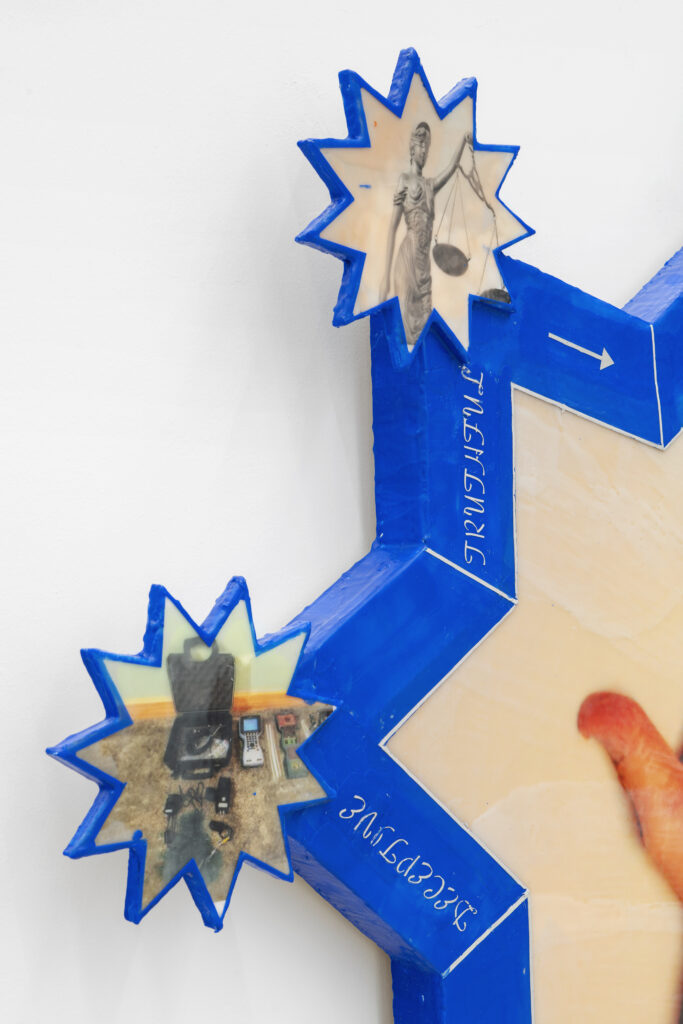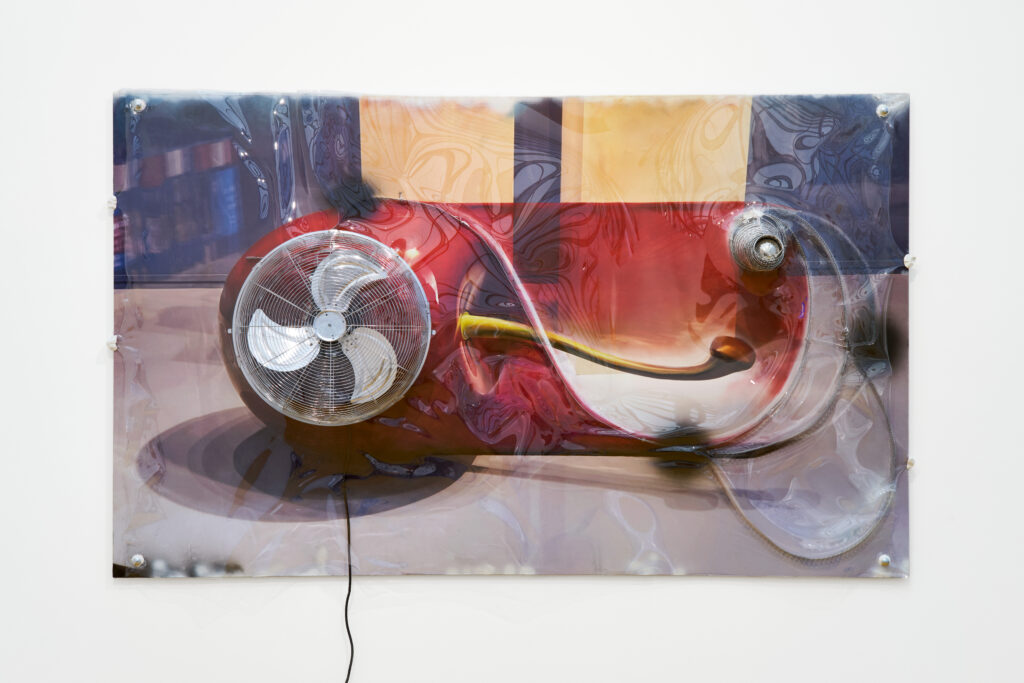Clima is pleased to present subliminal archipelagos a group exhibition with new works by Nina Hartmann, Marie Matusz, Jack O’Brien, Jay Payton.
Opening Reception 25.09.2024
from 6 to 9 pm
26.09.2024 – 23.11.2029
Photo: Flavio Pescatori
It appears clear that with the term archipelago we want to refer from the outset to a geography of bodies that are separate from each other, sometimes isolated, but with comparable features that it seems impossible not to read their union and the resulting relationship.
Subliminal archipelagos embrace a collection of works related to one another while not showing direct aesthetic evidence but emphasizing interactive processes of exchange that, just as in an archipelago, never occur hierarchically.
Loaded with visual stimuli and disparate sets of information, the exhibition becomes a shared visual experience in the navigation and discovery of individual exhibited units. Jay Payton‘s large abstract canvases in which stain of colors and multiple layers of oil paint seem to outlie familiar patterns and lines, create real cartographies within them, similar to organic circuits capable of connecting with each other. Nothing becomes programmatic and programmed in the process of Payton‘s works except a recurring gesture in the constant attempt to understand the human experience.
Analogous becomes the manipulation that Jack O’Brien adopt (...)
Clima is pleased to present subliminal archipelagos a group exhibition with new works by Nina Hartmann, Marie Matusz, Jack O’Brien, Jay Payton.
Opening Reception 25.09.2024
from 6 to 9 pm
26.09.2024 – 23.11.2029
Photo: Flavio Pescatori
It appears clear that with the term archipelago we want to refer from the outset to a geography of bodies that are separate from each other, sometimes isolated, but with comparable features that it seems impossible not to read their union and the resulting relationship.
Subliminal archipelagos embrace a collection of works related to one another while not showing direct aesthetic evidence but emphasizing interactive processes of exchange that, just as in an archipelago, never occur hierarchically.
Loaded with visual stimuli and disparate sets of information, the exhibition becomes a shared visual experience in the navigation and discovery of individual exhibited units. Jay Payton‘s large abstract canvases in which stain of colors and multiple layers of oil paint seem to outlie familiar patterns and lines, create real cartographies within them, similar to organic circuits capable of connecting with each other. Nothing becomes programmatic and programmed in the process of Payton‘s works except a recurring gesture in the constant attempt to understand the human experience.
Analogous becomes the manipulation that Jack O’Brien adopts in the use of materials by returning them deformed, distorted and deconstructed, not only in appearance but in the rich conglomerate of meanings or languages. The object finds itself trapped within its final form constrained even by this thin transparent and reflective membrane of deformed plastic, which simultaneously accentuates its morphology but prevents its full reading. Hearts on Ice, 2024 certainly aims to reflect on the more concurrent complexities experienced and related to the production of desire under the actual lens of extensive consumption culture.
Through Nina Hartmann‘s works, we are voluntarily exposed to a system of information, textual and photographic, which the artist collects, processes, and returns in the form of resin sculptures, encaustic decorated panels and vinyl screens. While Hartmann‘s visual code uses symbols understood as objective data of information (like crosshairs, framing lines and diagrams) it also draws on a complex symbolic system secularly and spiritually associated with mysticism and esotericism. The visual stimuli, sometimes scientific and technological other times photographic prints of evanescent figures, put the spotlight on Hartmann‘s investigation of systems of control and surveillance.
If we then add a temporal level to the concept of archipelago, it alludes to a cycle of relationships and coexistences that repeat and reinvent themselves, changing and altering but persisting as a collective entity. Composed of four Pictorico film prints framed in sequential plexiglass sheets, Between Nostalgia and Anticipation,2024 is Marie Matusz‘s new work that develops a choreography based on a blurred presence. Stories, reflected and refracted, are a guiding element as brief glimpses into a user’s life and the present is exhausted in the very moment of its perception by becoming past. In this view of reality we measure the past as memory in which the digestion of loss, understood as separation, drives us to an anticipation of the unknown potential that might be.
 Nina HartmannDivination Wheel (Handheld Lie Detector, ESP Potential Network), 2024
Nina HartmannDivination Wheel (Handheld Lie Detector, ESP Potential Network), 2024
Encaustic Medium, Pigment, Inkjet Print on spinning wood panel 127x136x6 cm
50x53.5x2.5in Nina HartmannDivination Wheel (Handheld Lie Detector, ESP Potential Network), 2024
Nina HartmannDivination Wheel (Handheld Lie Detector, ESP Potential Network), 2024
Encaustic Medium, Pigment, Inkjet Print on spinning wood panel 127x136x6 cm
50x53.5x2.5in Nina HartmannDivination Wheel (Handheld Lie Detector, ESP Potential Network), 2024
Nina HartmannDivination Wheel (Handheld Lie Detector, ESP Potential Network), 2024
Encaustic Medium, Pigment, Inkjet Print on spinning wood panel 127x136x6 cm
50x53.5x2.5in Jay PaytonThe Eternal Symbol, 2024
Jay PaytonThe Eternal Symbol, 2024
Oil on canvas 183x152,5 cm 72x60in Nina HartmannOrgone Accumulator Diagram, 2024
Nina HartmannOrgone Accumulator Diagram, 2024
Resin, Pigment, Acrylic paint, UV print
47x47x2,5 cm
18.6x18.6x1in Nina HartmannPolkadot Dress Conspiracy Mapping (Directional, Signage)
Nina HartmannPolkadot Dress Conspiracy Mapping (Directional, Signage)
2024
UV print on Vinyl, Steel Frame, Zip Ties
203x124 cm
80x49in Jack O’BrienHearts on Ice, 2024
Jack O’BrienHearts on Ice, 2024
Soft pastel, spray paint, photographic print mounted on aluminium, heat-formed PETG plastic, chrome-plater steel, epoxy putty, 87x23x120 cm
34x9x47in Jack O’BrienHearts on Ice, 2024
Jack O’BrienHearts on Ice, 2024
Soft pastel, spray paint, photographic print mounted on aluminium, heat-formed PETG plastic, chrome-plater steel, epoxy putty, 87x23x120 cm
34x9x47in Jack O’BrienHearts on Ice, 2024
Jack O’BrienHearts on Ice, 2024
Soft pastel, spray paint, photographic print mounted on aluminium, heat-formed PETG plastic, chrome-plater steel, epoxy putty, 87x23x120 cm
34x9x47in Jay PaytonAs The Hands from Heaven Reach Down to You on Judgement Day, 2024
Jay PaytonAs The Hands from Heaven Reach Down to You on Judgement Day, 2024
Oil on canvas
132x111 cm 52x44in Marie MatuszBetween Nostalgia and Anticipation, 2024
Marie MatuszBetween Nostalgia and Anticipation, 2024
Solvent UV resistant ink on Pictorico film
45,5 x 31 cm each
17x 12 ineach Marie MatuszBetween Nostalgia and Anticipation, 2024
Marie MatuszBetween Nostalgia and Anticipation, 2024
Solvent UV resistant ink on Pictorico film
45,5 x 31 cm each
17x 12 ineach Marie MatuszBetween Nostalgia and Anticipation, 2024
Marie MatuszBetween Nostalgia and Anticipation, 2024
Solvent UV resistant ink on Pictorico film
45,5 x 31 cm each
17x 12 ineach Jay PaytonA Spark Between Two Stones, 2024
Jay PaytonA Spark Between Two Stones, 2024
Oil on canvas
132x111 cm
9x12in
Nina Hartmann (b. 1990 in Miami FL) lives and works in Queens, New York. She received an MFA from The Yale School of Art in Painting & Printmaking in 2023 and a BFA from The School of the Art Institute of Chicago in 2013. Recent solo exhibitions include: Experience Machine, Glasshouse Projects, Gathering, London, UK (2024); Soft Power, Silke Lindner, New York, NY (2023); FOGBANK, Gern en Regalia, New York, NY (2020); Defanging Recovery Manual, with Suzanna Zak, In Lieu Gallery, Los Angeles, CA (2019). Recent group exhibitions include: SL X RE, Rose Easton, London, UK, Breaking up of ice on a river, Margot Samel, New York, NY, A Modern Disease–Like Jetlag, Cooper Brovenick, New York, NY (2024); A Signal Urgent But Breaking – Yale MFA Show, Perrotin, New York, NY, rhi-zome, organized by Adrienne Greenblatt, No Gallery, New York, NY (2023); JUNK IS NO GOOD BABY, Silke Lindner, New York, NY; The American Friend, Downs & Ross, New York, NY (2022); Jupiter Finger, Harkawik, Los Angeles, CA (2021).


install view
credits ChristianKnoerr
Jack O’Brien (b.1993) lives and works in London. He received his BA in Fine Art from Kingston University, London in 2014. In 2023 O’Brien received the Camden Art Centre Artist Prize at Frieze London. Recent solo exhibitions include: Nectar, Matthew Brown, Los Angeles, CA, Love Triangle, Aro, Mexico City (2024); The Theatre and Its Double, curated by Viscose Journal, Between Bridges, Berlin, DE (2023); The Answer, Sans Titre Invites, Paris (2023); To More Time, Lockup International, London (2022) and Waiting For The Sun To Kill Me, Ginny on Frederick, London, UK (2021). Recent group exhibitions include: Non-Specific Objects, Capitain Petzel, Berlin (2024); Right Now, Wrong Then, King’s Leap, New York (2024); Support Structures, Gathering, London, UK (2023); Memory of Rib, N/A Gallery, Seoul (2022); Chômage Technique, Lovaas Projects, Munich (2022); Something is Burning, Kunsthalle Bratislava, Slovakia (2022); An Insular Rococo, Hollybush Gardens, London (2022) and Strange Messengers, Peres Projects, Berlin (2018).

Jay Payton (b. 1992, Atlanta, GA) is a painter living and working in Brooklyn, NY. Selected solo exhibitions include: The Infinitesimal Man and His Ephemeral Existence, Gern en Regalia, New York, NY (2024); Into the Quantum Foam, april april, Brooklyn, NY, Hang Ten, presentation by Gern en Regalia, Brooklyn, NY (2021); Anytime You Try To Get Something From Nothing..You’re Gonna Suffer, Et. Al Gallery, San Francisco, CA (2019). Recent group exhibitions include: What’s That About? Anthony Meier, Mill Valley, CA (2023); Surplus in Pantomime, Alabama Contemporary Art Center, Mobile, AL, El Fua, Atlanta Contemporary Art Center, Atlanta, GA (2022); Here Now, Gone, Art in General, Brooklyn, NY The Place Behind Door, Leo Gallery, Hong Kong, With Higher Standards, Syndkt, Mexico City, Mexico (2019).














